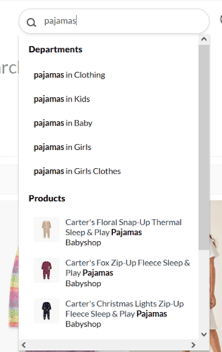
Searchandising: A Guide to Search and Merchandising
The results your site displays once a shopper clicks “search” are pivotal – the difference between a potentially frustrating experience and a seamless one. To maximize the relevance and sales potential of search results, sellers are seizing on a profitable new way to blend keyword matches with promotions: searchandising.
What is Searchandising?
In its most basic form, eCommerce site search narrows the range of products on your site to highlight the ones shoppers hope to find. But what if search could also help them discover relevant products they weren’t already thinking about? Enter searchandising, a blend of search and merchandising, which brings the art of merchandising to search results.
The formal searchandising definition is “the strategic application of merchandising tactics to the customer search experience.” Put more practically, searchandising improves product discovery and brings the power of traditional practices like product placement, inventory rotation, and cross-merchandising to the search experience.
Say a customer searches for “women’s rain boots.” Traditionally, the results would include waterproof boots and other rain-resistant footwear. With searchandising, results could prioritize new arrivals in the category and trending boots, while also suggesting related products like waterproofing spray or overshoes. The hallmark of searchandising is that the search results aren’t limited strictly to keyword matches, but include a curated assortment of other potentially relevant items, to boot.
What is a Searchandiser?
The searchandiser role on an eCommerce marketing team is responsible for optimizing the potential of on-site search, and can drive sales, enhance the customer experience, and deliver on KPIs. Success rests on the ability to leverage analytical thinking, creative problem-solving, and regard for the customer experience.
Effective searchandisers have a combination of skills and expertise:
- Data analysis capabilities to study and understand customer search behavior.
- Personalization know-how to refine the experience using customer data like browsing or purchase history.
- Merchandising coordination to align search results with promotional calendars and quarterly business goals.
- Awareness of compliance issues to ensure search functionality stays within the bounds of privacy regulations and standards
- Project and people management skills to make the most of eCommerce platform partnerships
Why is Searchandising Important?
Searchising is valuable because shoppers rely on eCommerce site search to connect them with relevant products. Currently, 43% of consumers head directly to the search bar when visiting a retailer’s website, according to Forrester. And overall, 78% of shoppers use the search function at some point during their visits to retail sites, Google found – making search the most widely-used way to find products.
Integrating searchandising into your eCommerce platform can speed the connection between customers and relevant offerings. It plays a pivotal role in converting visitors into customers and generating revenue growth. Business advantages include:
- Competitive advantage: A robust strategy for search merchandising can distinguish your business with a more efficient – even enjoyable – shopping experience tailored to meet customers’ needs. Your brand can earn a reputation for swift, relevant interactions from the first click onwards.
- Increased average order value: Laser-focused searchers might miss out on other offerings they may not know to look for. By presenting alternative product and category suggestions, you can raise awareness of the breadth of your product offering.
- Higher conversion rates: Optimizing eCommerce search functionality can boost conversion by up to 43%, ConversionXL found. By prioritizing the most relevant products and presenting highly curated product recommendations within search results, you can maximize the chances that shoppers will connect with something they want to buy.
- Optimized inventory management: You can throttle visibility of products and categories to move through inventory more quickly when there’s a backlog, highlight items that are nearly sold out, or downgrade items that can’t be delivered quickly.
What is a Searchandising Example?
Babyshop, a retail brand within the portfolio of the Landmark Group, employs robust tools to searchandise throughout the product discovery experience. Before shoppers even type a query, a drop-down menu displays trending keywords, featured categories and best-selling products, enabling instant access to top selections.
After clicking on the featured crib, a search on “pajamas” displays a drop-down featuring direct product links to baby onesies for sleep – perhaps leveraging session data to guess that someone searching for a crib has an infant rather than a school-aged child. The option to proceed directly to individual products is a potential shortcut on the path to purchase.
Selecting the option for “pajamas in Baby” produces a search results page featuring a variety of items and price points, with discounts highlighted and filters available to help sift through products. Shoppers view a seamless blend of products that match their search terms alongside promotional information, giving them a rich array of options to choose from.
How does Searchandising Work?
When a shopper visits a physical store in search of a particular item, merchandising on shelves, racks, and displays helps them locate what they set out to find, while also exposing them to other options along the way. eCommerce searchandising translates that experience into the online realm using algorithms that match shopper intent with relevant offerings.
The rise of artificial intelligence (AI) has supercharged search tools so they can process and analyze vast troves of website data to identify the right products and promotions to highlight – with picks adapting on the fly to new data generated as shoppers make their way through the site.
Depending on the algorithm, searchandising features can leverage:
- Shoppers’ search terms – using natural language processing (NLP), AI can not only interpret the words that were typed, but identify synonyms to enlarge the pool of potential relevant matches
- Product popularity, availability and sales – to determine a product’s relevance ranking, searchandising tools can factor in whether an item is frequently searched, viewed, or saved to wishlists, as well as its current earnings and inventory level
- Promotional offers – if shoppers are seeking sale items, searchandising tools can prioritize products with discounts attached
- Business rules – marketers can manually tip the scales for products or categories – for example, downgrading swimsuits in winter on a sporting goods site, while promoting ski and snow gear
- Customer profile information – Personalizing the results to take into account past purchases and preferences helps boost relevance
With these algorithmic selection and ranking capabilities as a foundation, marketers can deploy a range of searchandising tactics. Consider this hypothetical searchandising example of a shopper engaging with an outdoor outfitter’s eCommerce site:
1. Suggest Relevant Terms
After landing on your site, a customer starts typing “snow jacket” into the search bar and instantaneously sees a drop-down list of possible terms: snow boots, snow jacket, snow pants, and so on. Linked images offer a potential shortcut directly to relevant products. .
2. Curate Search Results:
Because the searcher used the word “snow,” the results set prioritizes ultra-warm jacket styles. In addition, past purchase information suggests the customer might be interested in garments made with sustainable materials and is willing to pay premium prices, so the results reflect those preferences, as well as limiting the display to only those items available in the buyer’s size.
3. Enhance Discovery
The search results page can include visual merchandising and relevant filters encourage further engagement. High-quality images or video of jackets in action further direct attention to likely matches.
4. Invite Exploration
Design space alongside search results to feature complementary items and matching accessories. A banner highlighting a 10% discount offer on accessories when purchased with a jacket accompanies a display of gloves, scarves and hats from eco-friendly brands, incentivizing the customer to consider adding more items to their cart.
5. Provide Social Proof
Reviews within search results indicate which jackets have been tried and tested by other customers. The shopper can use search tools to sort and filter by top-rated, popular or trending items.
What are Some Current Searchandising Challenges?
The potential benefits of implementing searchandising are substantial – but the risks of flawed execution can undermine your brand. Before implementing a searchandising strategy, it’s crucial to understand potential pitfalls. Among the hurdles are the following:
1. System Integrations Can Be Overwhelming
To get the most out of searchandising, you need real-time data sharing that ensures consistency across touchpoints and ultra-relevant recommendations. The machine learning and AI that power searchandising algorithms require comprehensive data sets to deliver personalized results to customers. Integrations with back-end retail systems like inventory management, customer relationship management, and content management systems are a must, but can be challenging to set up.
2. Management of Rules/Categories is Complex
It’s neither realistic nor sustainable to manually manage the product selection or promotions that appear in search results, and it’s impossible to scale. Business rules help automate these decisions – but with the increasing number of demands and priorities within sophisticated eCommerce operations, it can be easy to overlap or mismanage parameters.
3. Staying Fresh Requires an Investment
Searchandising works best when product information, descriptions, and related content stay relevant and up-to-date and the search mix reflects current trends and seasonal variations. Marketing teams need to invest in fresh content and searchandising maintenance time to ensure the experience stays engaging.
4. Site Performance May Need a Boost
As searchandising strategies grow more sophisticated, incorporating real-time personalization and complex algorithms, data processing can slow your site performance. Investment in monitoring and content delivery networks can help speed load times.
What are Some Common Searchandising Strategies?
When you enhance your eCommerce capabilities with searchandising, you leverage automation to deliver at scale the relevant experiences shoppers want. To make the most of searchandising, incorporate these five strategies:
1. Personalize
- The ability to surface picks that best match individual preferences and context is what gives searchandising meaning and impact. . . Tools such as Monetate’s Dynamic Bundles enable you to group items for presentation as suggested add-ons or related products in search results. In addition, search results provide rich fodder for personalizing the entire site experience, enabling your site to display product suggestions, cross-sells, and content that reflect past searchers.
2. Optimize for Mobile
- More than 44% of eCommerce sales are forecast to occur on mobile devices in 2024, according to Insider Intelligence, so it’s essential to develop search experiences that are efficient and easy to use on small screens. In addition, you can factor in a shopper’s device type to better hone results: If iPhone customers purchase higher-priced items, for example, you can prioritize more expensive product matches for that audience.
3. Align Search Results with Your Goals
- With searchandising, you can change the default order of search results based on business KPIs – for example, by prioritizing products that convert at a higher rate if your aim is to boost search conversion, or by showing sale items whose inventory is reaching the end of its seasonal life. Just be sure to balance these business needs with keyword relevance, and give shoppers the tools to sort and filter the initial set of results so they can focus on what they need.
4. Eliminate Dead Ends
- Nearly half of consumers, 48%, abandon sites altogether after unsuccessful searches, according to Google, so it’s essential to avoid a blank “no results” page. Instead, use searchandising to suggest synonyms and potentially relevant products and categories. Fold in links to buying guides and highlight promotional offers so shoppers are encouraged to click onwards or try their search again.
5. Track and Optimize Search Performance
- As you hone searchandising techniques, track performance carefully to ensure you’ve got the right balance of promotional suggestions, personalization, and exact keyword matches. KPIs include search click-through rate (CTR), search abandonment, search conversion rate, and search revenue per visitor.

Why is a Searchandising Tool Essential to Your Ecommerce Business?
Searchandising is a powerful eCommerce tool for creating tailored, engaging, and low-friction retail experiences for shoppers. Its ability to drive greater purchases leads to stronger customer loyalty and has positive impacts on ROI.
Monetate’s Personalized Search can deliver best-in-class searchandising backed by patented machine learning algorithms to build and deliver winning experiences smarter and faster.


